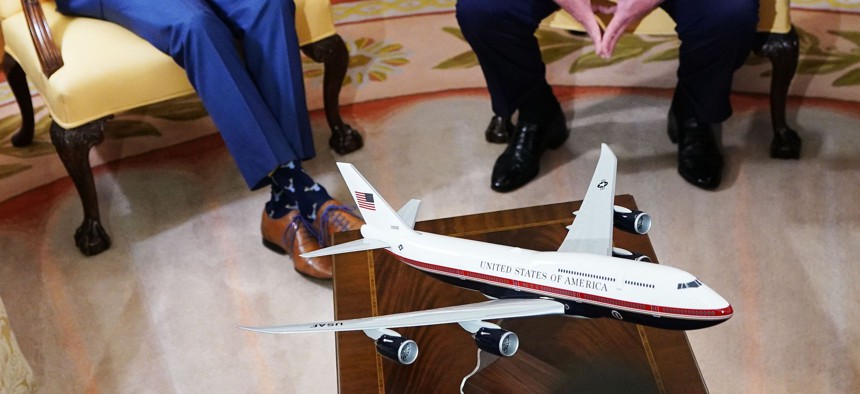
A model of Air Force One with a new color scheme is seen during a bilateral meeting between US President Donald Trump (R) and Canada's Prime Minister Justin Trudeau, June 20, 2019. AFP via Getty Images / MANDEL NGAN
Boeing Can’t Find Enough Workers to Build the New Air Force One
A new GAO report details the latest setback for the presidential planemaker.
Boeing is having trouble hiring qualified aircraft mechanics to build the new Air Force One as it competes in an ultra-competitive labor market, according to a new government report.
It’s the latest setback for the planemaker as it tries to get the high-profile presidential plane effort back on track following other problems that have delayed the project at least two years.
Difficulties in finding skilled workers are hardly unique to Boeing; companies across the United States have struggled to find employees for specialty positions. But Boeing is unique because it needs skilled workers who can also pass a comprehensive security clearance process in order to work on the top-secret aircraft, which the Air Force calls the VC-25B.
“Employees must meet stringent security requirements to work on the VC-25B program because of its presidential mission,” the Government Accountability Office said Wednesday in a new report to Congress. “VC-25B officials said that Boeing continues to work with the program office to improve the prescreening process for applicants to ensure timely processing of security clearances.”
Boeing has run into numerous problems converting two already-built 747-8 jetliners into a flying White House. The company has lost more than $1.1 billion on the projects. To date, the company has blamed the delays on workforce issues related to the pandemic and a legal dispute with a company that was supposed to customize the planes’ interiors. Boeing has never explicitly said it did not have enough workers.
Still, Boeing has been advertising job openings for Air Force One workers since at least 2020. The company’s hiring website lists at least 11 job openings related to the new Air Force One at a factory in San Antonio, Texas. Workers can “build the flying Oval Office in San Antonio,” the company website states.
“You'll build the next Air Force One, one of the most technologically-advanced aircraft in the sky, and your skills will be challenged every day,” the website states. “Your future is built here.”
Boeing finished “major structural modifications” to the first of two aircraft and is expected to finish the same work on the second aircraft by the end of the spring, GAO said in the report. The planes must now undergo extensive wiring.
“[W]iring remains a risk because over 2,000 wire bundles and 200 miles of wire—almost double that of a commercial [Boeing] 747 aircraft—will be installed on the aircraft,” GAO said. “Wiring must meet a broad set of complex requirements from electrical protection to proper separation, according to VC-25B officials.”
A Boeing spokesperson was not immediately available for comment.







